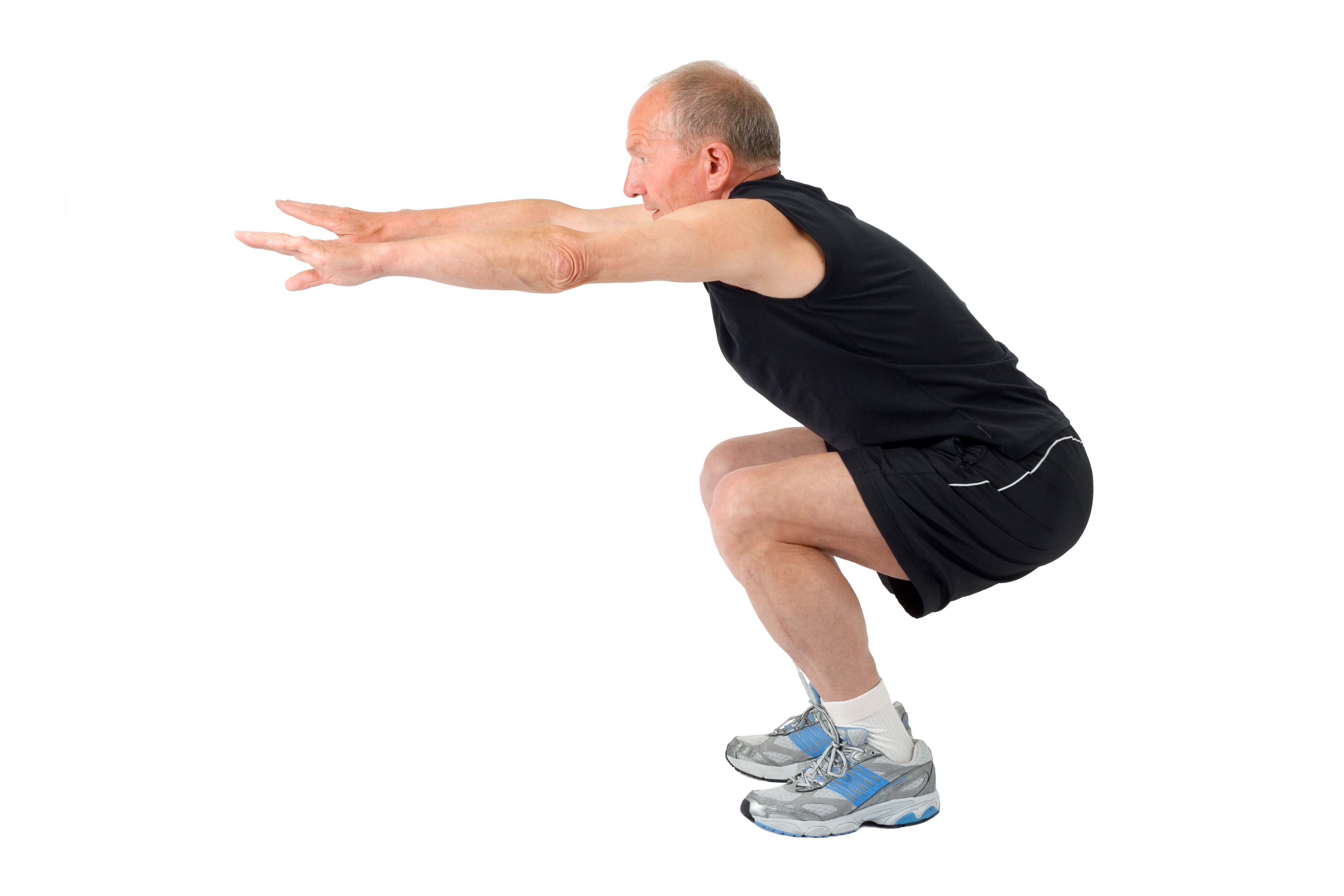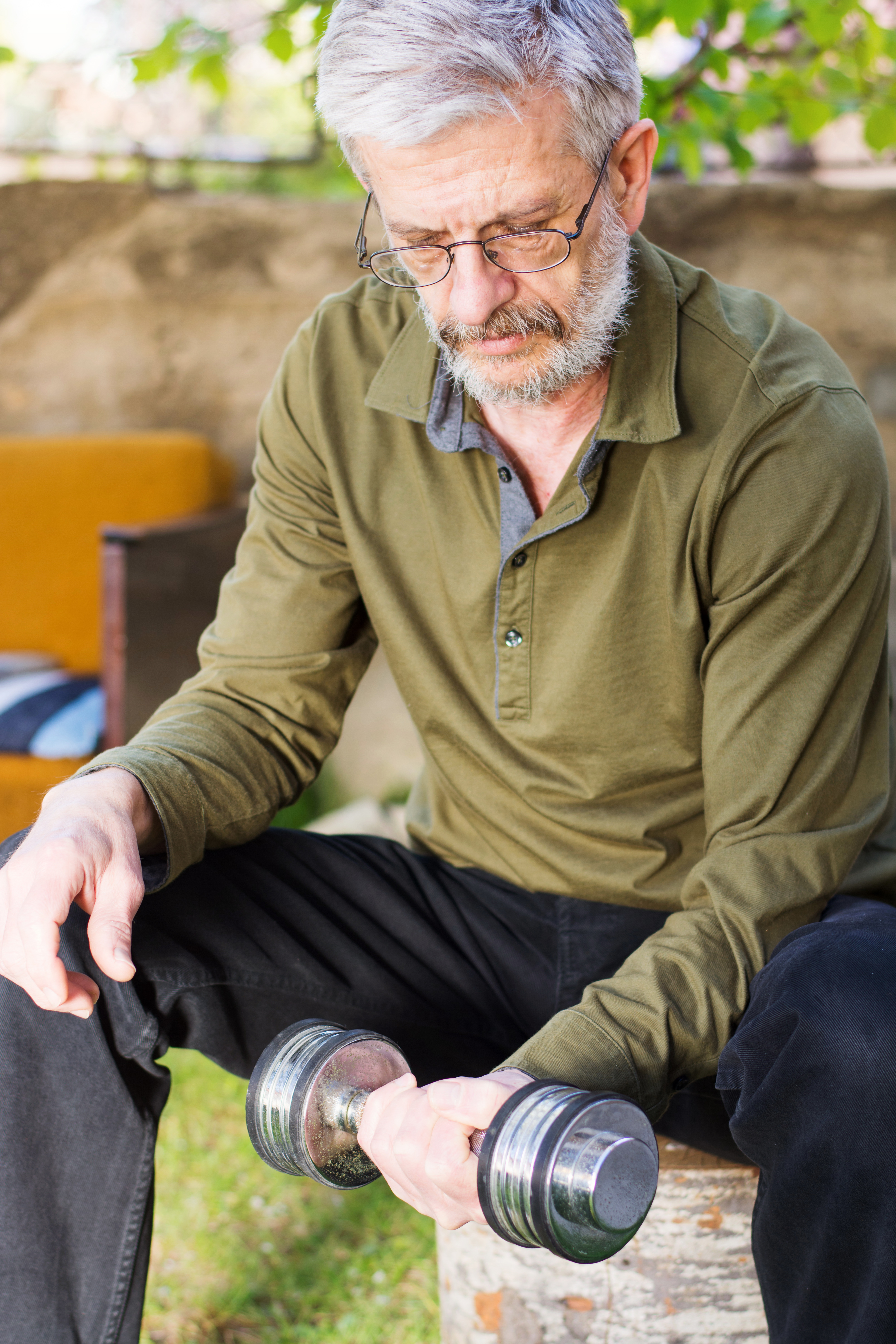It’s important to continue an active lifestyle as we age to maintain strong and flexible muscles and according to AARP, regular physical exercise can even slow down the aging process.
Here are some helpful physical fitness tips to help you stay in shape as you age:
Where to start
It’s very important to get clearance for physical activity from a physician. A physician’s assessment of your physical stamina will help with determining a physical fitness routine that will work for you. When starting a program, it’s always important to start slow. Over-doing a strenuous workout too soon can lead to injury.
What to work on
Lower body strength can help prevent a fall. Rising up on your toes, squats, and lunges are all good exercises that use body weight. Walking is a good exercise for stamina and will also help to strengthen the legs.
Sample workout:
 Senior man demonstrating how to do a squat
Senior man demonstrating how to do a squat
1. Stand straight with your feet hip-width apart aligned with shoulders.
2. Tighten the core stomach muscles.
3. Slowly lower the body into a sitting position.
4. Hold for five seconds
5. Slowly straighten the legs back into a standing position.
6. Repeat eight to 10 times.
Upper body strength can help seniors do everyday activities like lifting, reaching, pulling and pushing. Having good upper body strength can preserve, or in some cases, reverse muscle loss associated with aging. Exercises you can do to build arm strength include doing bicep curls and upright dumbbell rows with light weights.
Sample workout:
 Demonstrating an arm curl with a dumbbell.
Demonstrating an arm curl with a dumbbell.
- Stand with feet shoulder-width apart.
- Hold weights straight down at sides, palms facing forward. Breathe in slowly.
- Breathe out slowly and bend the elbows and lift weights toward chest. Keep elbows at the sides on the body.
- Hold the position for one second.
- Breathe in slowly and lower the arms.
- Repeat eight to 12 times.
Flexibility is important to help reduce the risk of injury when exercising. It also helps reduce muscle soreness and allows the body greater amounts of freedom in movement. Stretching your upper and lower body muscles also increases flexibility and will help make it easier to reach, lift or stand.
Sample workout:
 Sitting in a chest stretch pose with hands behind the back.
Sitting in a chest stretch pose with hands behind the back.
This exercise, which stretches the chest muscles, is also good for your posture.
- This stretch can be done while standing or sitting.
- Hold arms to the sides at shoulder height, with palms facing forward.
- Slowly move the arms back, while squeezing shoulder blades together. Stop when stretching or if there is slight discomfort.
- Hold the position for 10-30 seconds.
Be aware of your body
When it comes to exercise it’s important not to do anything that feels painful or doesn’t feel comfortable. Try your best to stay within a pain free range of motion. This will help maintain mobility and prevent injury, mostly due to falls.
Speaking of falls, there are easy tips to follow to help prevent them, like keeping the floor free of tripping hazards like cords, wrinkles in the carpet and turned corners on rugs. Make sure you’re using proper athletic sneakers, use a mat for traction, and be sure to move aside any exercise equipment like dumbbells when they’re not in use.
It’s also important to be aware of balance when changing positions. When you’re changing from a lying or sitting position to standing, take a minute to make sure you’re not experiencing lightheadedness.
Be sure to talk to your doctor about medications that may cause dizziness or drowsiness. Lastly, don’t forget to stay well hydrated by drinking plenty of water.
The benefits of physical fitness
Seniors will see small improvements if they exercise on a consistent and regular basis. Seniors may notice they feel steadier on their feet, or even can bounce back quicker from an illness.
Recognizing the potential benefits of improved fitness, Elderwood designed the Right Moves Program for seniors with the goal of improving health and independence. This program takes a unique approach to senior physical fitness by using senior fitness specialists, who are certified through the American Council on Exercise.
Click here to learn more about the Right Moves wellness program.